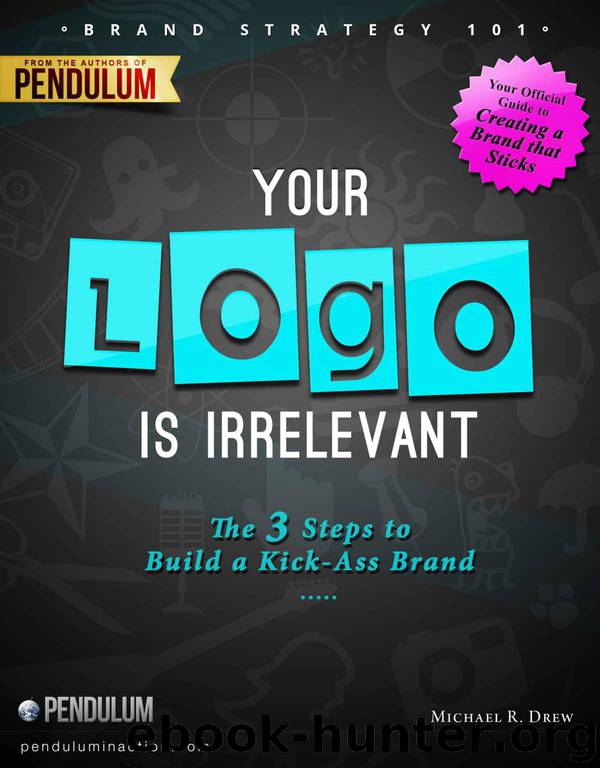Brand Strategy 101: Your Logo Is Irrelevant - The 3-Step Process to Build a Kick-Ass Brand (The 7 Steps to a Successful Business in a Changing Market) by Drew Michael R

Author:Drew, Michael R. [Drew, Michael R.]
Language: eng
Format: epub
Publisher: Beneath the Cover Press
Published: 2012-12-31T18:30:00+00:00
Step 2: Consistency
Consistency requires that you deliver a valued experience to your audience. Pavlov rang the same bell before every feeding, with the same tone. He didn’t alter sounds. Nor did he vary what came after the bell. He wanted those dogs to recognize the sound of that bell and to associate it immediately with one thing, the taste of meat. In the same way you want people to associate your name and your company with a particular prized experience every time they think of that value.
Get consistent in your marketing campaigns to create your brand personality. This will be your “meat paste,” so to speak, to trigger your audience’s associations of you and your company. Put together a memorable style guide to give your campaigns a sense of “connectedness.”
Make ads distinctive to stand apart from your competitors. Two good words on which to build your style guide are “always” and “never.” Decide what things will always be in your ads and what will never be in your ads. A tight style guide makes your company feel reliable in the mind of your customer.
Once you’ve got consistency in your style guide, it’s time to get consistency in getting in front of your audience on a regular basis.
Does your business offer new management techniques? Then offer to speak at no charge at local business college and community colleges. Then keep using the keywords and phrases that encapsulate your insightful business concepts. If you have a logo, make sure you consistently display it whenever and wherever you can.
Seth Godin, author of more than a dozen bestsellers, including Purple Cow and Permission Marketing, understands the importance of frequency and consistency in a book marketing and public relations campaign. He practices these through following these seven steps:
Permission marketing. This is a process by which marketers ask permission before sending ads to prospects. Godin pioneered the practice in 1995 with the founding of Yoyodyne, the Web’s first direct mail and promotions company (it used contests, online games, and scavenger hunts to market companies to participating users). He sold it to Yahoo! three years later.
Editorial content. Godin was a long-time contributing editor to the popular Fast Company magazine.
Blogging. Seth's Blog is one of the most-frequented blogs.
Public speaking. Successful Meetings magazine named Godin one of the top 21 speakers of the 21st century. Words used to describe his lectures include "visual," "personal," and "dynamic."
Community-building. His latest company, Squidoo.com, ranked among the top 125 sites in the U.S. (by traffic) by Quantcast, allows people to build a page about any topic that inspires them. The site raises money for charity and pays royalties to its million-plus members.
E-books. Godin took a step to publish all his books electronically, then worked with Amazon on his own imprint, Domino, which published 12 books. Recently, Godin ended that project – since as he said in a blog, it was a "project" and he is always looking for more and different opportunities.
Download
This site does not store any files on its server. We only index and link to content provided by other sites. Please contact the content providers to delete copyright contents if any and email us, we'll remove relevant links or contents immediately.
Influence: The Psychology of Persuasion by Robert B. Cialdini(4681)
The Miracle Morning by Hal Elrod(4532)
The Hacking of the American Mind by Robert H. Lustig(4281)
Pre-Suasion: A Revolutionary Way to Influence and Persuade by Robert Cialdini(4114)
Unlabel: Selling You Without Selling Out by Marc Ecko(3569)
Ogilvy on Advertising by David Ogilvy(3474)
Hidden Persuasion: 33 psychological influence techniques in advertising by Marc Andrews & Matthijs van Leeuwen & Rick van Baaren(3433)
Purple Cow by Seth Godin(3120)
Who Can You Trust? by Rachel Botsman(3072)
Kick Ass in College: Highest Rated "How to Study in College" Book | 77 Ninja Study Skills Tips and Career Strategies | Motivational for College Students: A Guerrilla Guide to College Success by Fox Gunnar(3056)
This Is Marketing by Seth Godin(2952)
The Marketing Plan Handbook: Develop Big-Picture Marketing Plans for Pennies on the Dollar by Robert W. Bly(2923)
I Live in the Future & Here's How It Works by Nick Bilton(2916)
The Power of Broke by Daymond John(2855)
Building a StoryBrand by Donald Miller(2822)
The 46 Rules of Genius: An Innovator's Guide to Creativity (Voices That Matter) by Marty Neumeier(2753)
Draw to Win: A Crash Course on How to Lead, Sell, and Innovate With Your Visual Mind by Dan Roam(2714)
The Tipping Point by Malcolm Gladwell(2657)
Market Wizards by Jack D. Schwager(2612)
